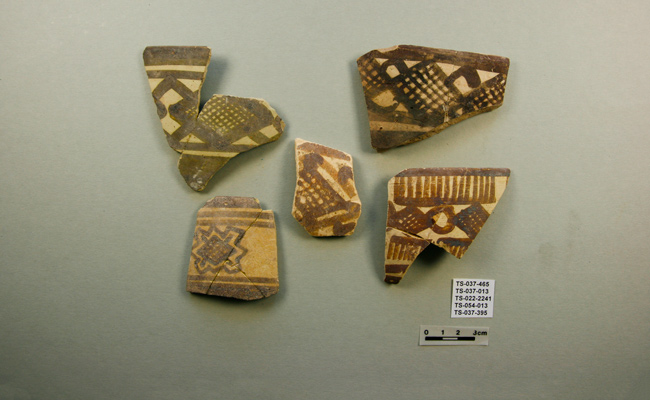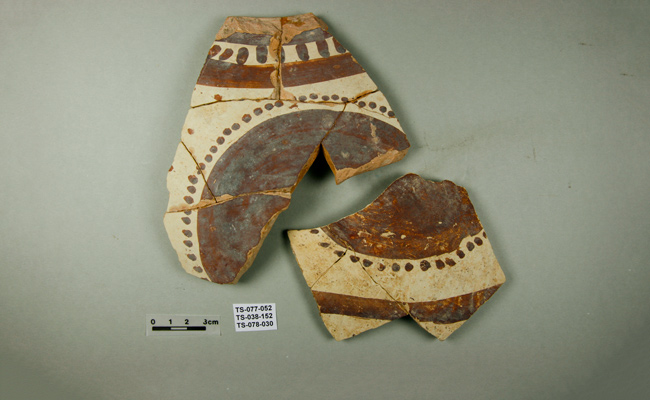This research project analyzed 5th millennium pottery from the Iranian site of Tepe Sohz which was excavated briefly in the early 1970s. The goal of the pottery analysis was to evaluate two competing models for the socio-economic and political development of 5th millennium BCE societies in southwestern Iran, one proposal by William Sumner (1994) and the other by Abbas Alizadeh (1988, 2010). Both models assign craft specialization an important position. However, while Alizadeh attributes such specialization to surplus from herding activities, Sumner claims that it is due to a surplus stemming from agriculture.
Research
Background
The ceramic material for this project was provided by a project for the study of previously excavated material from Tepe Sohz under the direction of Susan Pollock (funded by the German Research Foundation (DFG)). In 1970, Hans J. Nissen (1973; Nissen and Redman 1971) undertook a survey and soundings in the Behbehan and Zohreh plains in southwestern Iran. Ceramic finds from excavations at the largest site in these two valleys, Tepe Sohz, have so far remained unstudied, whereas the survey material was published by Reinhard Dittmann (1984). Since Nissen’s work, more recent intensive surveys in the lowlands, the Zagros valleys north and east of Behbehan, as well as salvage excavations due to dam construction have resulted in numerous new insights into the settlement development and social structure of 5th millennium BCE southwestern Iran.
- There were large central sites covering an area of up to 15 ha; several of these sites were surrounded by smaller settlements.
- Agriculture was a mainstay of subsistence. However, the intensity with which it was pursued remains unknown.
- This is the first period when settlements were inhabited for lengthy durations; furthermore, they show substantial architectural remains.
- Exotic goods (e.g. copper, lapis lazuli) were exchanged in small quantities over long distances.
- In this region, the fifth millennium BCE is the earliest period with an emerging production of pottery beyond the scale of a household. A few weeks of excavations at Tepe Sohz alone resulted in an assemblage of more than 25.000 sherds.
- Two-storey kilns have been found at many sites, and there are even entire site layers or sites consisting solely of kilns.
- The large majority of the pottery is painted. These sherds can be classified into two main styles: painted Susiana wares from the lowlands in the southwest and painted Bakun pottery in the highlands in the east.
Based on these characteristics, A. Alizadeh and W. Sumner developed two competing models of the political economy of these societies, both of which assume that craft specialization was located at large sites. Alizadeh suggests that pastoral nomads dominated social hierarchies and maintained close relations with central places. They exchanged animals and animal products against goods manufactured by specialists in sedentary communities. In contrast, Sumner focuses on agriculture, claiming that agricultural surplus produced in small villages was consumed in the larger settlements or was used for compensating craft specialists.
Tepe Sohz is situated midway between the Susiana and Bakun regions. Its location relatively close to the Persian Gulf makes it a preferred place for winter camps of nomads today. According to Alizadeh’s model, this would also have been the case in the Early Chalcolithic.
Research
The first step in the project was to classify the pottery from Tepe Sohz based on the style of painted motifs (see S. Pollock, Iranian Journal of Archaeology and History 13(2)/14(1):7-9, 2000) into four distinct stylistic groups:
- Ceramics with strong parallels to the region of Fars in the East (Fig.1);
- Ceramics with clear parallels in the Susiana Plain in the west;
- Ceramics without parallel, probably a local style. One of the frequently occurring motifs are disks with one row of peripheral dots, giving this motif a sun-like appearance. This motif is found frequently at Tepe Sohz, but only very rarely at other sites (Fig.2.).
- Fragments that are un-attributable to any of the first three groups. There are two reasons for this. On the one hand, general geometric patterns occur at both sites lowland Susiana sites and in the highlands. On the other hand, many sherds are so small that entire motifs cannot be reconstructed.
The goal was to use pXRF analyses to identify whether and to what extent non-locally produced pottery was used at Tepe Sohz; equally important was the question of whether Tepe Sohz itself was responsible for the production and distribution of pottery in the plains of Behbahan and Zohreh. Using these results, we wanted to test the theses of Alizadeh and Sumner: a scenario with vertical nomadism would likely point towards close relations to the highland, but not to the lowlands further west, while the second, agriculturally oriented model would not predict any preference for lowland or highland connections. Rather, pottery from sites surrounding Tepe Sohz should show the same chemical composition as that from Tepe Sohz itself.
pXRF and WD-XRF analyses of a large sample of sherds from groups (A), (B) and (C) were carried out with the following specific questions in mind:
- What was the share of non-local pottery at the site of Tepe Sohz?
- Do non-local groups of sherds correlate with highland- or lowland-related styles?
- Is all local pottery similar in terms of clay source(s) used?
Results
The lab results were evaluated with a cluster analysis so that all sherds were grouped according to their compositional similarity of their clay. The resulting XRF groups are not easy to distinguish, and they do not match any of the three stylistic groups (local, highland- and lowland-affiliated). Therefore, an XRF analysis of a few 5th millennium sherds from other sites from the survey in the Behbahan and Zohreh valleys was undertaken. These diverge clearly from all of those from Tepe Sohz, showing that the Tepe Sohz pottery was a local production. Furthermore, the few survey sherds seem to have site-specific clay compositions, pointing to a highly localized pattern of pottery production and use.
Interpretation of these results indicates local pottery production, contradicting both the expectations derived from Alizadeh’s mobility-based model as well as those based on Sumner’s redistribution scenario.


